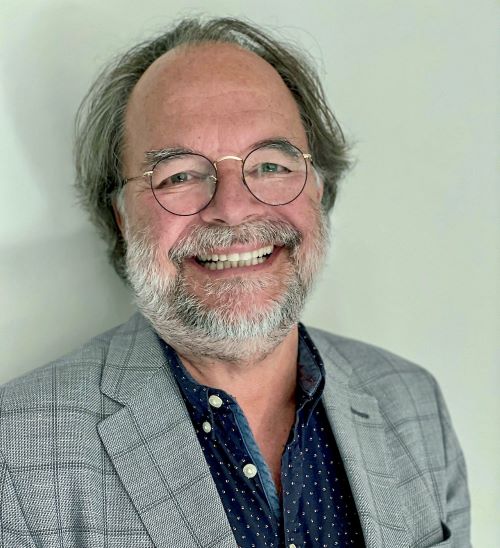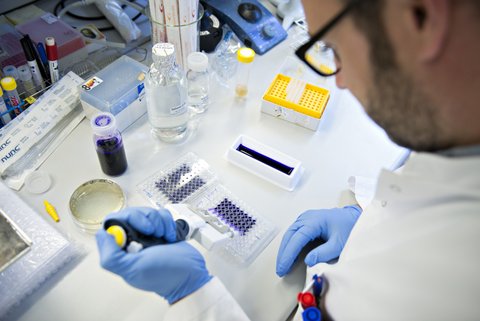Novel Drugs for Resistant Bugs
Reduced antibiotic efficacy against infections has broad health, social and economic impacts, including severely constrained therapy options for people undergoing state of the art medical procedures. For more than a decade, we have been developing a new type of antimicrobial drug paradigm that can mitigate the impact of antimicrobial resistance on the prevailing antibiotic therapies.

Antimicrobial resistance, generally known by the acronym as AMR, has been acknowledged ever since the discovery of antibiotics. Bacteria carrying genes conferring resistance to a classic antibiotic, are readily isolated among billions of their sensitive counterparts simply by selective growth in the presence of the antibiotic. Nowadays, genetic marker elements of resistance are traceable among millions of unrelated bacteria in the environment and in higher organisms by “deep sequencing” methodologies.
Nevertheless, I consider those well-known and traceable antibiotic markers, including their mode of actions, as the low hanging fruits of understanding the complexity of AMR; they constitute the tip of a gigantic iceberg representing nature’s evolution of potential resistance mechanisms. With the emerging failure of the present antibiotics, WHO calls for immediate action to preserve their power. A large fraction of today’s prevalent infections develops in parallel with demographic changes, misuse of antibiotics and a substantial increase in modern medical procedures.
Similar to the pharmaceutical industry, many scientists and clinicians don’t seem to acknowledge the contribution and importance of the biofilm life-mode to the developing AMR crisis. Bacteria that form biofilms during infection are in a high AMR life-mode. At CBC this is taken into account in our contemporary drug development and effective intervention principles. I find it critical to inspire pharma to restart the antimicrobial drug discovery process with new concepts, new targets, and new types of chemical entities to fill the clinical need for efficient antimicrobial treatment options in support of antibiotic stewardship.
- Sygeforsikringen Danmark
- Innoexplorer
- Cystic Fibrosis Trust UK
- Novoseed
- Research and Innovation Fund
- FTP
- Lundbeck Foundation
- FNU
- Kemira
- Kirsten & Freddy Johansens Research Prize
- Novoseed
- Villum-Kann Rasmussen Foundation
- DSF
- FTP
Major Domestic Partners
Research is done in close collaboration with: Prof. Tim Tolker-Nielsen and his team at Costerton Biofilm Center :: Assoc. Prof. Katrin Qvortrup and her team at the Chemical Biology Group at DTU :: Prof. Claus Moser and his team at Costerton Biofilm Center and the Clinical Microbiology Department at Rigshospitalet :: Assoc. Prof. Daniel Midjord-Belstrøm at Department of Odontology.
Major International partners
Prof Alain Filloux, Director of SCELSE, Singapore
Prof Urs Jenal, Biocentrum, University of Basel, Switzerland
Dr. Florentin Constancias, Department of Health Sciences and Technology, ETH Zürich, Switzerland
Prof Roland Seifert, Hannover Medical School, Germany.
Prof Paul Williams, University of Nottingham, United Kingdom.
Prof Liang Yang, Southern University of Science and Technology, Shenzhen, China
- Identification of small molecules that interfere with c-di-GMP signaling and induce dispersal of Pseudomonas aeruginosa biofilms. Andersen JB, Hultqvist LD, Jansen CU, Jakobsen TH, Nilsson M, Rybtke M, Uhd J, Fritz BG, Seifert R, Berthelsen J, Nielsen TE, Qvortrup K, Givskov M, Tolker-Nielsen T. Nature Biofilms Microbiomes. 2021 7:59. https://doi.org/10.1038/s41522-021-00225-4 Impact Factor 7.5
-
Periodontitis associates with species-specific gene expression of the oral microbiota. Belstrøm D, Constancias F, Drautz-Moses DI, Schuster SC, Veleba M, Mahé F, et al.
- Antibiotics inhibit tumor and disease activity in cutaneous T-cell lymphoma. Lindahl LM, Willerslev-Olsen A, Gjerdrum LMR, Nielsen PR, Blümel E, Rittig AH, Celis P, Herpers B, Becker JC, Stausbøl-Grøn B, Wasik MA, Gluud M, Fredholm S, Buus TB, Johansen C, Nastasi C, Peiffer L, Kubat L, Bzorek M, Eriksen JO, Krejsgaard T, Bonefeld CM, Geisler C, Mustelin T, Langhoff E, Givskov M, Woetmann A, Kilian M, Litman T, Iversen L, Odum N.Blood. 2019 Sep 26;134(13):1072-1083. doi: 10.1182/blood.2018888107. Epub 2019 Jul 22.PMID: 31331920 Impact Factor 17.5
- Small Molecule Anti-biofilm Agents Developed on the Basis of Mechanistic Understanding of Biofilm Formation. Qvortrup K, Hultqvist LD, Nilsson M, Jakobsen TH, Jansen CU, Uhd J, Andersen JB, Nielsen TE, Givskov M, Tolker-Nielsen T. Front Chem. 2019 Nov 1;7:742. doi: 10.3389/fchem.2019.00742. eCollection 2019.PMID: 31737611 . Impact Factor 3.99
- Reactivity and Synthetic Applications of Multicomponent Petasis Reactions. Wu P, Givskov M, Nielsen TE. Chem Rev. 2019 Oct 23;119(20):11245-11290. doi: 10.1021/acs.chemrev.9b00214. Epub 2019 Aug 27.PMID: 31454230 Impact Factor 54
- Increased Intracellular Cyclic di-AMP Levels Sensitize Streptococcus gallolyticus subsp. gallolyticus to Osmotic Stress and Reduce Biofilm Formation and Adherence on Intestinal Cells. Teh WK, Dramsi S, Tolker-Nielsen T, Yang L, Givskov M. J Bacteriol. 2019 Feb 25;201(6):e00597-18. doi: 10.1128/JB.00597-18. Print 2019 Mar 15.PMID: 30617242 Impact Factor 3.2
- Metagenomic and metatranscriptomic analysis of saliva reveals disease-associated microbiota in patients with periodontitis and dental caries. Belstrøm D, Constancias F, Liu Y, Yang L, Drautz-Moses DI, Schuster SC, Kohli GS, Jakobsen TH, Holmstrup P, Givskov M. Nature Biofilms Microbiomes. 2017 Oct 2;3:23. doi: 10.1038/s41522-017-0031-4. eCollection 2017.PMID: 28979798 Impact Factor 7.5
- Detection of Pathogenic Biofilms with Bacterial Amyloid Targeting Fluorescent Probe, CDy11. Kim JY, Sahu S, Yau YH, Wang X, Shochat SG, Nielsen PH, Dueholm MS, Otzen DE, Lee J, Delos Santos MM, Yam JK, Kang NY, Park SJ, Kwon H, Seviour T, Yang L, Givskov M, Chang YT. J Am Chem Soc. 2016 Jan 13;138(1):402-7. doi: 10.1021/jacs.5b11357. Epub 2016 Jan 4.PMID: 26684612 Impact Factor 14.6
- In silico analyses of metagenomes from human atherosclerotic plaque samples. Mitra S, Drautz-Moses DI, Alhede M, Maw MT, Liu Y, Purbojati RW, Yap ZH, Kushwaha KK, Gheorghe AG, Bjarnsholt T, Hansen GM, Sillesen HH, Hougen HP, Hansen PR, Yang L, Tolker-Nielsen T, Schuster SC, Givskov M. Microbiome. 2015 Sep 3;3:38. doi: 10.1186/s40168-015-0100-y.PMID: 26334731 Impact Factor 13.6
- Dispersed cells represent a distinct stage in the transition from bacterial biofilm to planktonic lifestyles. Chua SL, Liu Y, Yam JK, Chen Y, Vejborg RM, Tan BG, Kjelleberg S, Tolker-Nielsen T, Givskov M, Yang L. Nat Commun. 2014 Jul 21;5:4462. doi: 0.1038/ncomms5462.PMID: 25042103 Impact Factor 12.1
- First case of E anophelis outbreak in an intensive-care unit. Teo J, Tan SY, Tay M, Ding Y, Kjelleberg S, Givskov M, Lin RT, Yang L. Lancet. 2013 Sep 7;382(9895):855-6. doi: 10.1016/S0140-6736(13)61858-9.PMID: 24012265 Impact Factor 60.4
- Ajoene, a sulfur-rich molecule from garlic, inhibits genes controlled by quorum sensing. Jakobsen TH, van Gennip M, Phipps RK, Shanmugham MS, Christensen LD, Alhede M, Skindersoe ME, Rasmussen TB, Friedrich K, Uthe F, Jensen PØ, Moser C, Nielsen KF, Eberl L, Larsen TO, Tanner D, Høiby N, Bjarnsholt T, Givskov M. Antimicrob Agents Chemother. 2012 May;56(5):2314-25. doi: 10.1128/AAC.05919-11. Epub 2012 Feb 6.PMID: 22314537 Impact Factor 4.9
Staff list
| Name | Title | Phone | |
|---|---|---|---|
| Andersen, Jens Bo | Associate Professor | +4535320649 | |
| Givskov, Michael | Professor | +4535327855 | |
| Hultqvist, Louise Dahl | Associate Professor | +4535327860 | |
| Nielsen, Thomas Eiland | Affiliate Professor |


